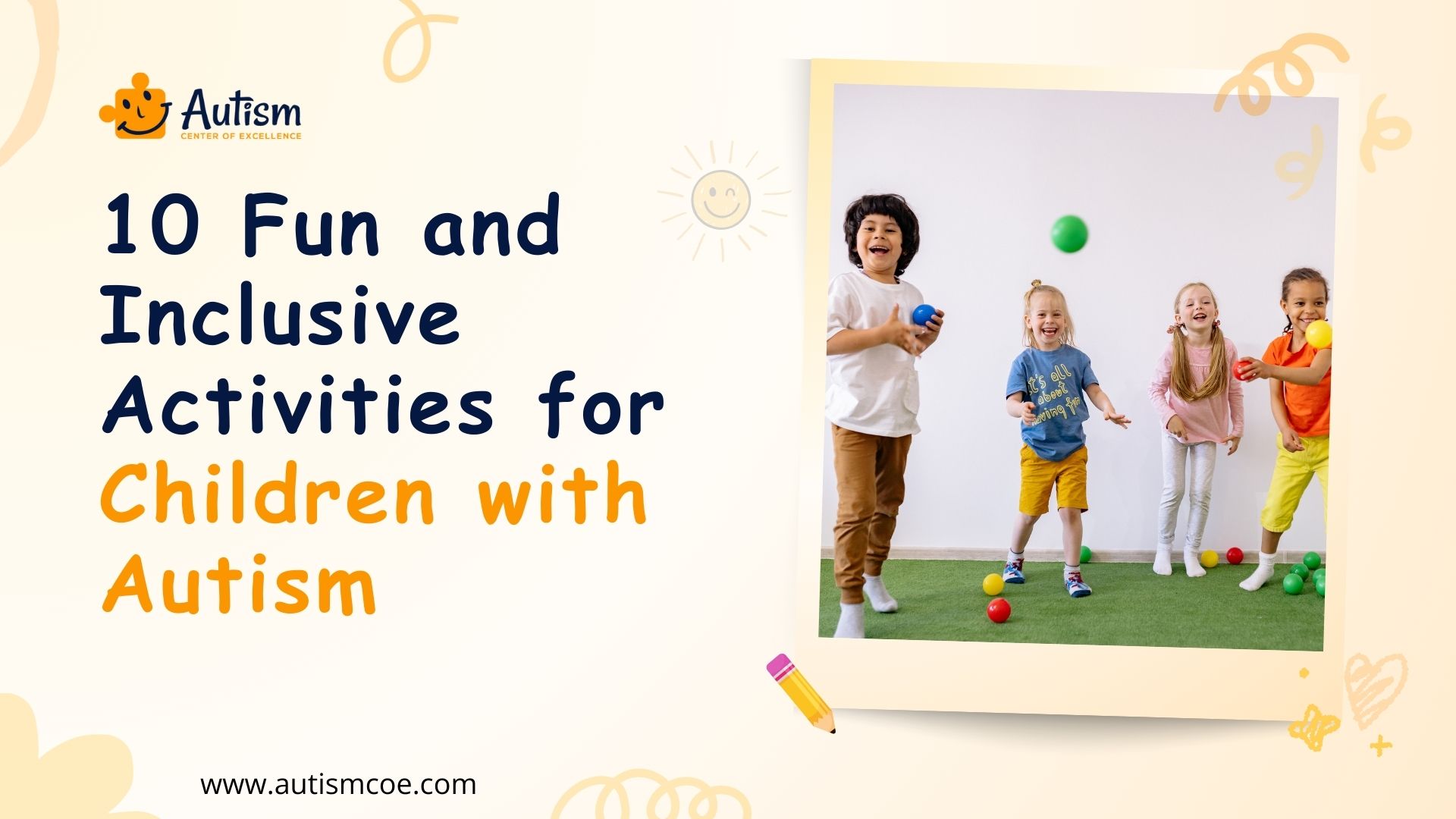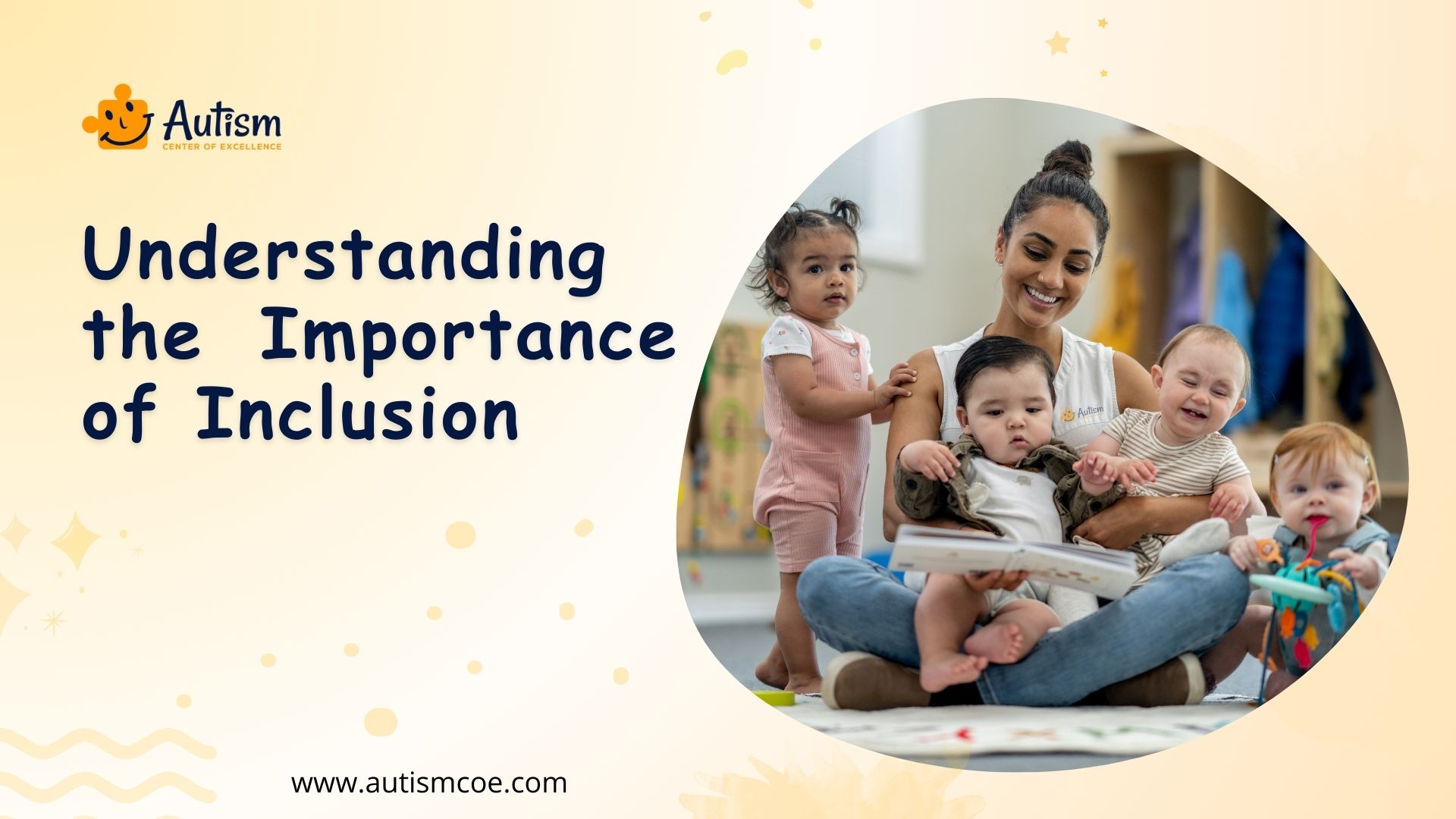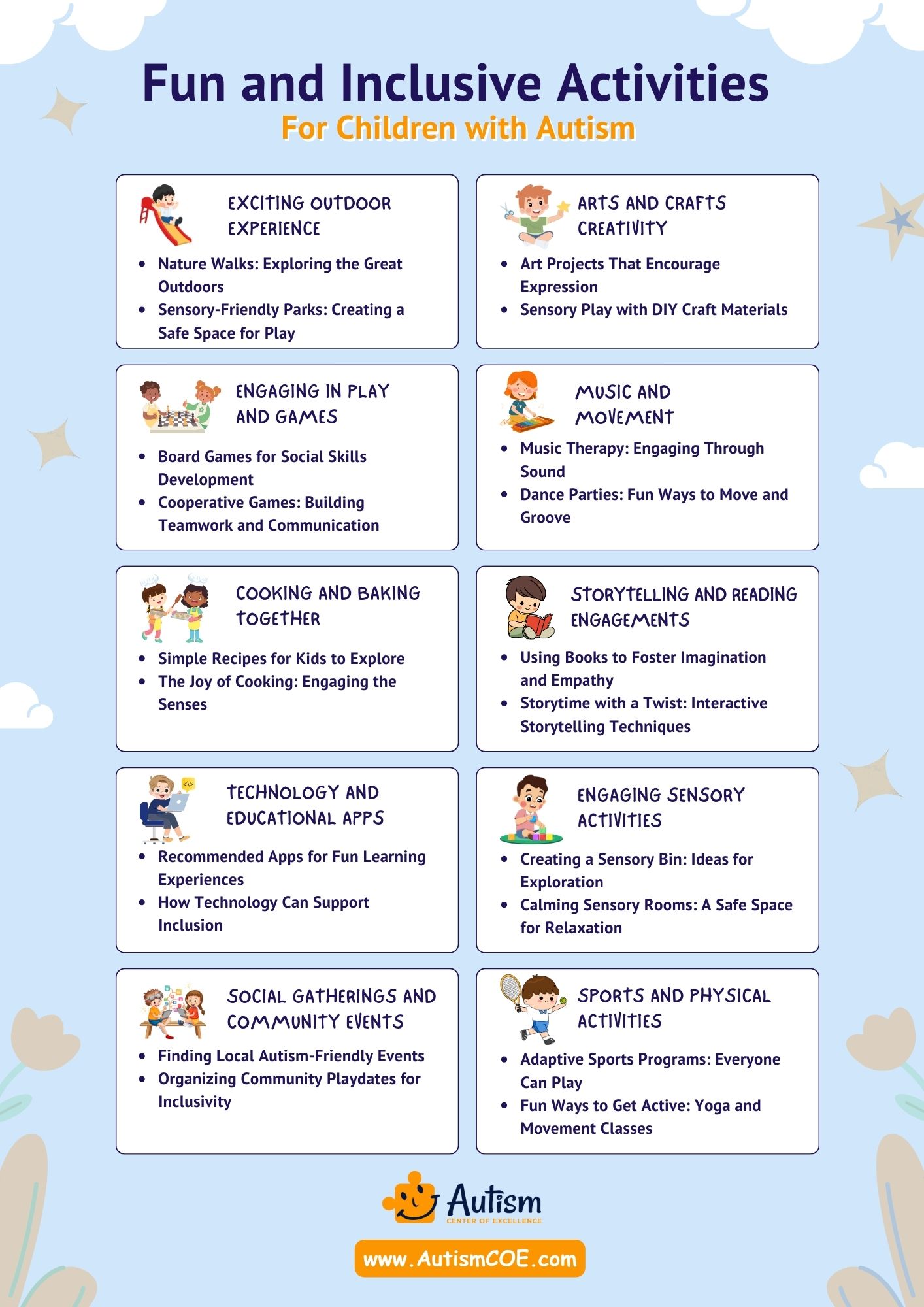10 Fun and Inclusive Activities for Children with Autism

Every child should delight in the joy of playing, learning, and exploring the fascinating world around them. For children with autism, each small activity can make a significant impact on their development and well-being. This blog is specially crafted for parents, caregivers, and educators who are eager to discover a diverse range of entertaining and inclusive activities. Whether you’re looking for hands-on crafts, interactive games, or sensory experiences, you’ll find valuable resources and ideas here to help create meaningful and enjoyable experiences for your child.

Understanding the Importance of Inclusion
Inclusion refers to developing environments whereby every child, regardless of ability or challenge, is treated the same with respect and valued equally. Activities children with autism need, therefore, are those that will impact social skills, creativity, and physical well-being. These can improve their development while at the same time creating understanding and sympathy among peers in a Class Environment, at home, and in the community.

1. Exciting Outdoor Experience
Nature Walks: Exploring the Great Outdoors
Nothing soothes you as nature does. Taking children with autism on nature walks will re-anchor them to a broader environment, thus preventing the impacts of stress and working on their attention. Fresh air, sounds, and sundry sights are stimulating and a perfect place to learn in such a wonderful manner. Try to take your children to local parks or nature reserves where you can see plants, birds, and insects up close in their natural surroundings.
Sensory-Friendly Parks: Creating a Safe Space for Play
Some communities introduce Sensory-Friendly parks designed for children who have autism. These parks feature equipment specifically designed to cater to the sensory needs of the children, offering supportive seating swings and quiet rooms for retreat when a child feels overwhelmed. These parks provide an ideal outdoor Activity for Autistic Children, ensuring they feel secure while enjoying physical play.
2. Arts and Crafts Creativity
Art Projects That Encourage Expression
Art is very beneficial to children with autism as a means of communication for self-expression. Even the simplest projects, such as painting, drawing, and even clay modeling, help them express their feelings. This makes them understand the use of varied materials given to them since they can play with different textures and colors, which will help develop fine motor activity skills and creativity.
Sensory Play with DIY Craft Materials
Basically, it is any ordinary activity that has sensory play for autistic children. This could include playdough, kinetic sand, or paper with different textures to stimulate the senses and encourage creative thinking in a child. DIY materials can be prepared by parents and teachers using simple household items like rice, beans, or pasta, and they will come out as fun as well as inexpensive avenues for learning through play.
3. Engaging in Play and Games
Board Games for Social Skills Development
Board games are the best tool for social skills activities for children with autism. Games like Connect Four or Guess Who? will teach them to wait for their turn patiently, behave themselves while playing, and win graciously while losing game tastefully. These games will also help communicate ideas and listen to others when we get them to talk out their thoughts as well as understand what others express.
Cooperative Games: Building Teamwork and Communication
Cooperative games are all about working together and not competition. So, they suit children with autism very well. For example, in “The Floor is Lava” and “Build a Tower,” communication and cooperation are used to achieve the same purpose. These activities increase social and cognitive skills and, therefore, strengthen the sense of belonging and understanding of other children.
4. Music and Movement
Music Therapy: Engaging Through Sound
Music Therapy can especially help children with autism to advance their Communication and Social Skills. Engaging them in singing, playing instruments, or listening to music would allow them to express themselves and connect with others. Music can ease anxiety and cause great joy; therefore, it is an important component of daily routines.
Dance Parties: Fun Ways to Move and Groove
Nothing is more delightful for kids than moving their bodies to enjoy dancing. This activity helps enhance their coordination and rhythm. Let different genres of music create various movements and expressions in a dance session held at home or school. Dancing is actually an activity that fosters creativity and offers freedom, and hence, it is an amiable thing for all children.
Enjoying Reading?
Join Our Weekly Newsletters!
Subscribe now to stay updated with our latest email updates.
5. Cooking and Baking Together
Simple Recipes for Kids to Explore
Cooking is a wonderful activity that connects children with autism to fun and real life. Simple recipes such as sandwich making, fruit salad, or baking cookies help them observe and learn instructions, enhancing their Fine Motor Skills. Moreover, enjoying their tasty products strengthens their confidence and cultivates a sense of accomplishment.
The Joy of Cooking: Engaging the Senses
Cooking involves contact, smell, and taste of ingredients. Combining these experiences is what lets your children feel and understand the different elements they can encounter in life. Cooking also encourages the ability to learn how to create a good meal. It can be used as an intergenerational bonding activity that positively enhances relationships and love for food and creativity.
6. Storytelling and Reading Engagements
Using Books to Foster Imagination and Empathy
Auditory storytelling for children with autism develops their creativity and enables them to understand people’s perspectives. Choose books that have splendid illustrations and interesting stories that will fascinate them. Read the story together, questioning them and asking them to provide their opinions and feelings.
Storytime with a Twist: Interactive Storytelling Techniques
Interactive storytelling makes the reading session even more enjoyable. Using props, puppets, or even costumes can bring stories to life as children start to get involved in the storyline. As a result, it creates emotional connections and helps to understand readers better, increasing the pleasure of reading and making reading even a memorable experience.
7. Technology and Educational Apps
Recommended Apps for Fun Learning Experiences
Technology can be an excellent auxiliary to assist children with autism. Educational apps, such as “Endless Alphabet” or “Proloquo2Go,” are fun ways to teach language, math, or social skills to kids. Considering diverse learning styles, the apps offer tailored experiences for each child’s requirements.
How Technology Can Support Inclusion
This inclusion can be provided by making available usable learning tools in the classroom or at home through technology. Children with autism can make use of these digital devices to interact and connect with their peers and teachers. Technology serves as a link for children with autism to participate fully in activities and experiences of daily life.
8. Engaging Sensory Activities
Creating a Sensory Bin: Ideas for Exploration
Sensory bins are an activity that can quickly captivate children with tactile discovery. Fill a container with rice, beans, or sand and drop in some small toys or objects for them to find. Imaginative play offers limitless opportunities, especially for children with autism, to enhance Sensory Integration and focus.
Calming Sensory Rooms: A Safe Space for Relaxation
Providing a Child with Autism with a sensory room in the house or the classroom can be a peaceful hideaway for playing. Fill the space with soft lighting, comfortable seating, and sensory tools like a weighted blanket or noise-canceling headphones. The comfort of providing a small, secure space where a child can relax, recharge, and feel safe is truly invaluable.
9. Social Gatherings and Community Events
Finding Local Autism-Friendly Events
Community events allow autistic children to have friendships and new experiences. Find Autism-Friendly events around you, including sensory-friendly movie nights, art classes, or sports programs. These create chances for interaction from children who also share an experience.
Organizing Community Playdates for Inclusivity
Organize playdates among other families of this autism community and encourage children to interact with one another. Organise activities that interest children from time to time so that everybody gets included. Community playdates help form stronger bonds among families while building a sense of belonging and support.
10. Sports and Physical Activities
Adaptive Sports Programs: Everyone Can Play
Adaptive sports programs allow children with autism to be included in physical activity. Everyone can now take part in specially provided sports for their ability, such as those through organizations like Special Olympics. They include activities that improve physical fitness, teamwork, and confidence in achieving maximum potential.
Fun Ways to Get Active: Yoga and Movement Classes
Yoga and movement classes form an excellent means of boosting balance, coordination, and concentration in children who have autism. Many studios provide special classes designed for them, using sensory-friendly methods. The classes cultivate a safe space for little ones to find movement and a sense of mindfulness.

The Role of ABA Therapy in Inclusive Activities
ABA is the widely practiced and established behavior intervention approach designed to promote skills on social interaction, communication, as well as learning through reinforcement procedures. Specific interventions for every child diagnosed with autism will indeed include ABA Therapy, making it an effective tool in bringing about inclusion in many activities. A child with autism can be reinforced through the step-by-step breakdown into manageable steps and consistency in rewarding so they can participate more effectively in group social settings.
Incorporating ABA Principles in Play
One of the ways through which ABA therapy principles can be effectively used in inclusive activities is through structured play. For example, when there is a group game, educators or caregivers make use of Positive Reinforcement in order to encourage turn-taking and sharing. For every time that a child waits, they turn in the game, praise or a small reward may be lavished on the child. Focus has been reinforcing the behavior, so that a child would associate social interaction with positive outcomes.
Frequently Asked Questions & Answer
What Types of Activities Are Best for Children With Autism?
Activities that are rich in senses, interactive, and structured such as art projects, sensory bins, and cooperative games will most likely promote social interaction.
How Can I Make Group Activities More Inclusive?
Adapt activities so that they are accessible to all students, provide visual support, and define roles so that each child feels comfortable and confident participating.
What Are Some Sensory-friendly Activities?
Sensory-friendly activities involve water play, sand trays, and nature walks and are designed to be calming, based on each child’s preferences.
How Do I Encourage Social Skills Through Play
Use games that organize activity in such a way as to allow mutual help, turn taking, and opportunities to share by which a child’s interaction with peers is inevitably promoted.
Conclusion
Most children with autism find extra value in engaging in enjoyable and friendly activities as part of their daily routine. These activities offer opportunities for self-expression, Social Interaction, and growth, contributing to their overall development. At AutismCOE, we recognize the importance of these approaches in fostering a supportive environment. This, in turn, fosters participation and celebrates achievements, building confidence and resilience and empowering them to reach their full potential.
Including ABA therapy in inclusive activities provides an organized way to help children with autism. Positive reinforcement and targeted interventions allow caregivers and educators to provide enriching experiences that enhance social skills, communication, and a Sense of Belonging. Whether through play, arts, or community involvement, ABA principles can add joy to inclusive activities for all children.
Please Note: The content of this blog is for informational purposes only and should not be considered a substitute for professional medical advice, diagnosis, or treatment. Consult a qualified healthcare professional for personalized guidance tailored to your specific situation.

Bhavika Bhasin
Bhavika Bhasin is the Research and Marketing officer at AutismCOE. She works with children and adults with ASD. Her clinical research includes evaluating various available autism screening and diagnosis methods and their efficacy. She is currently developing a novel screening exam that is indicated to be more accurate than the existing available exams. She is also writes articles papers for various publications.

